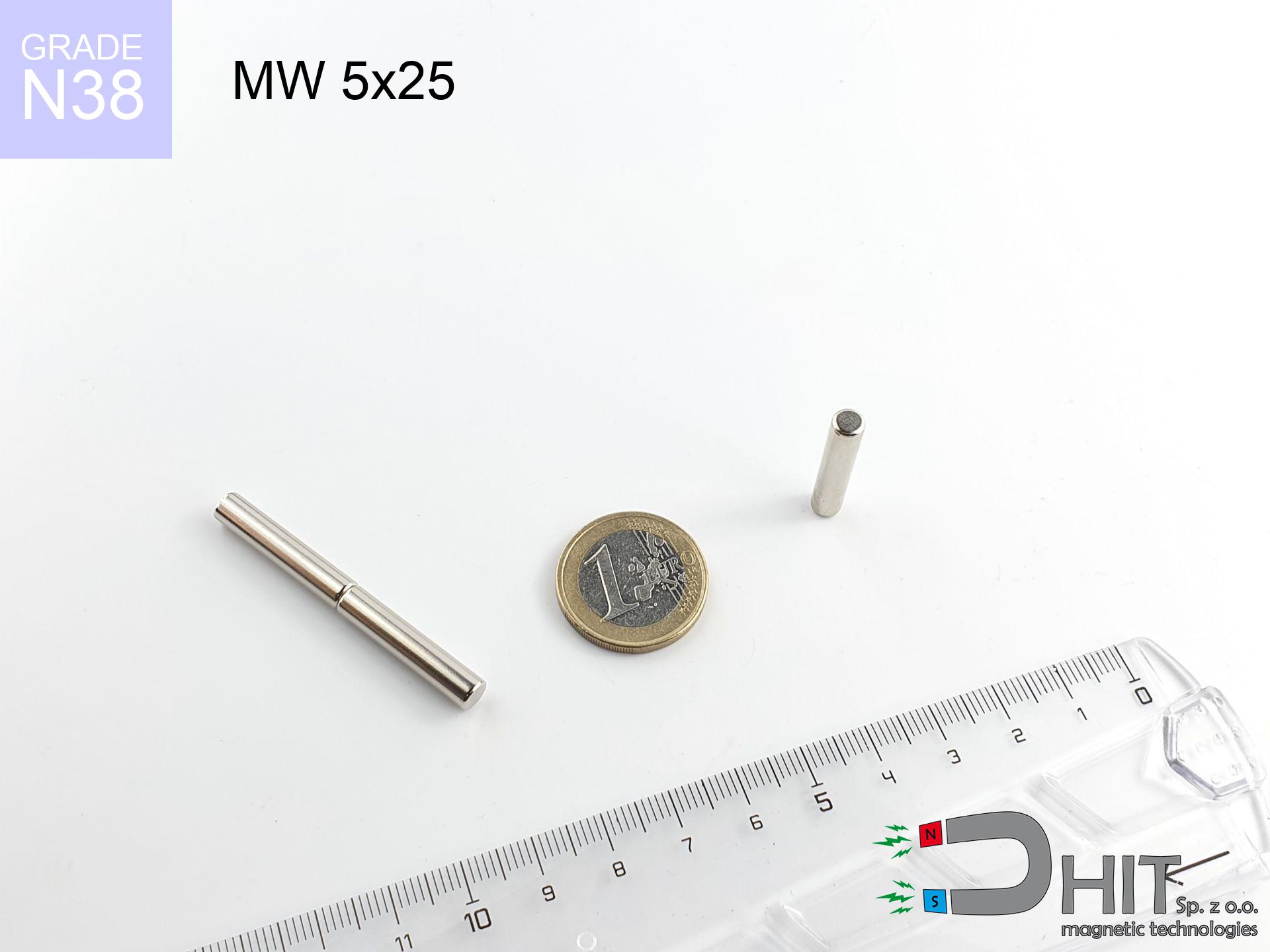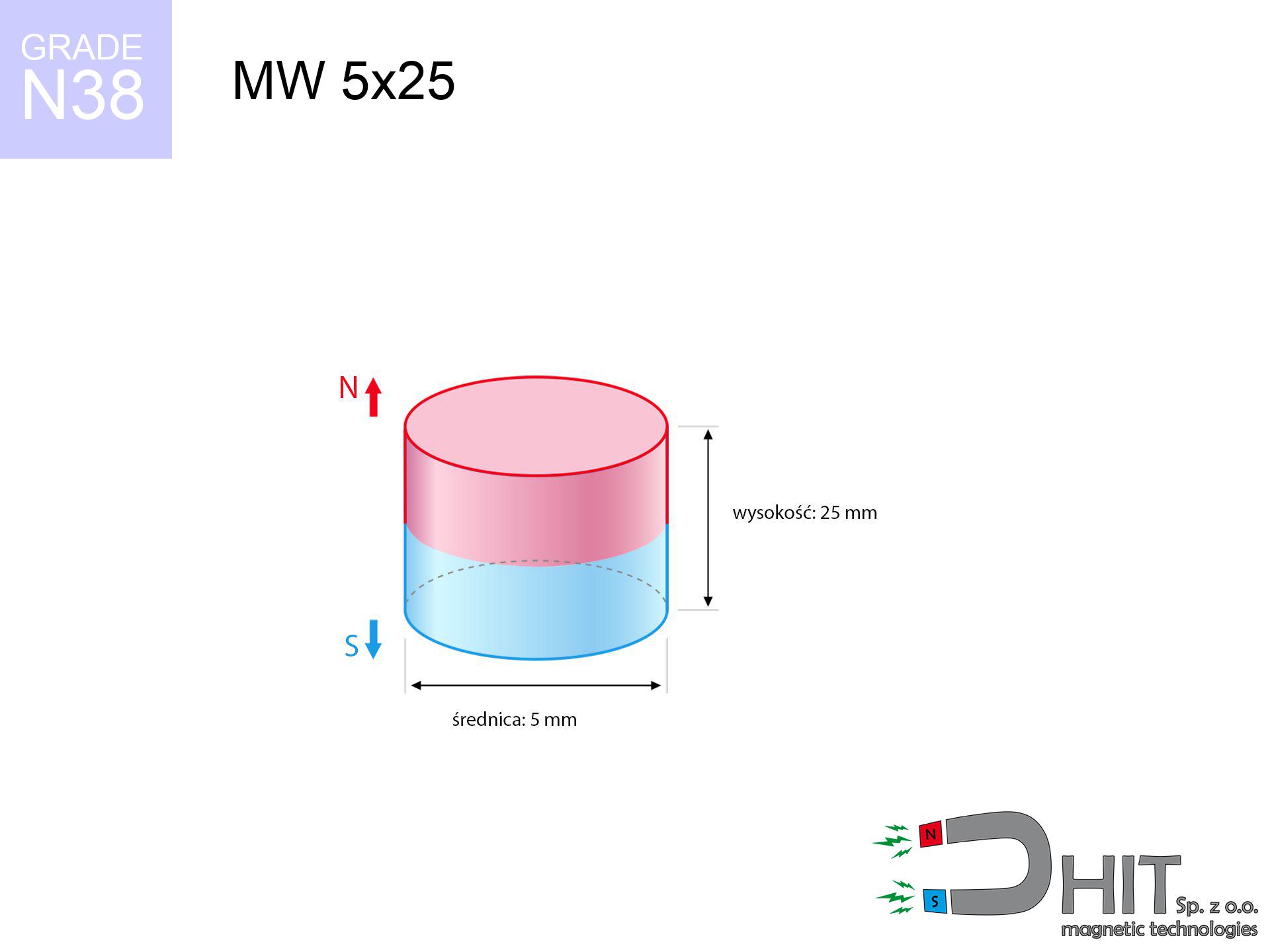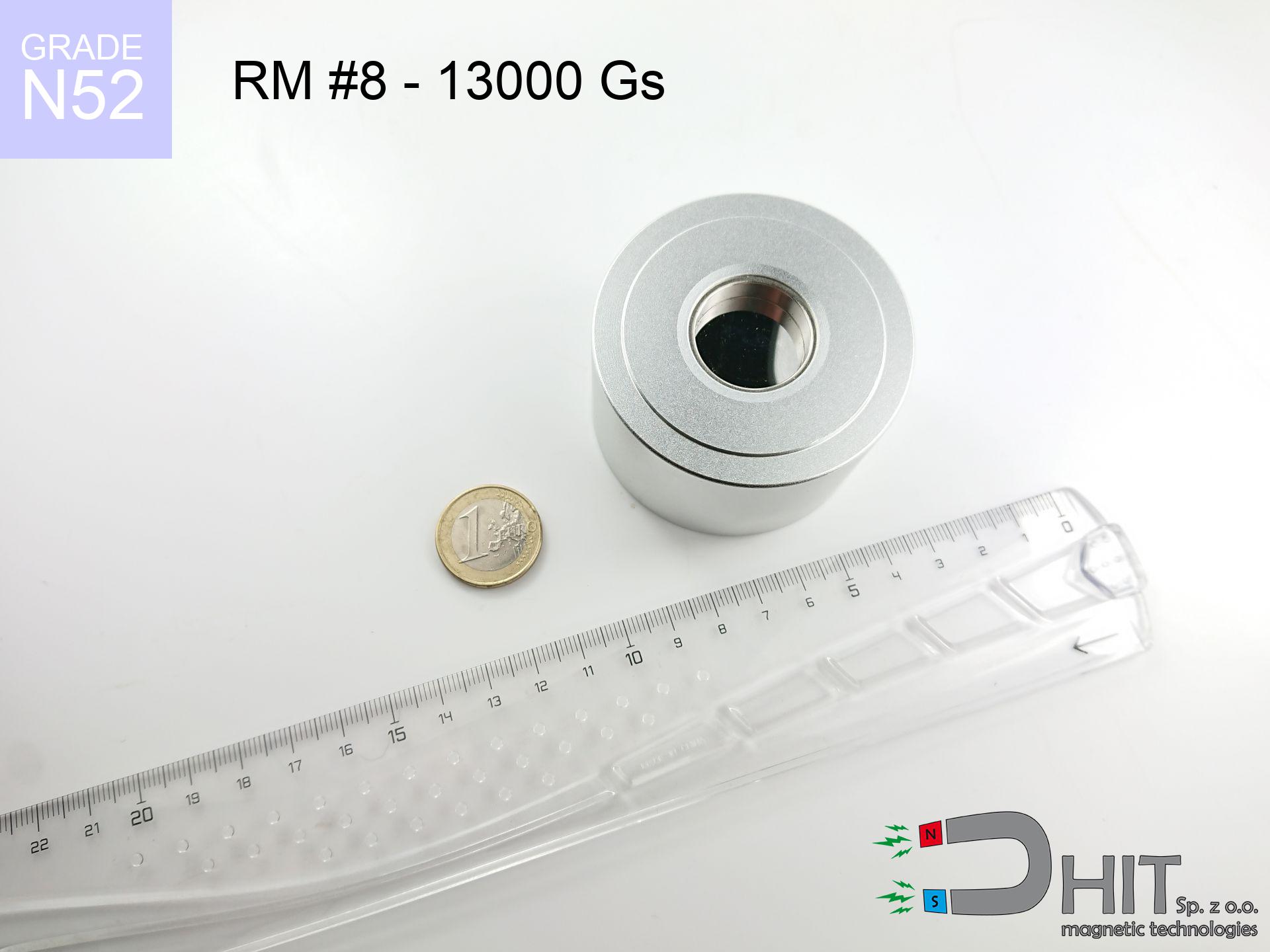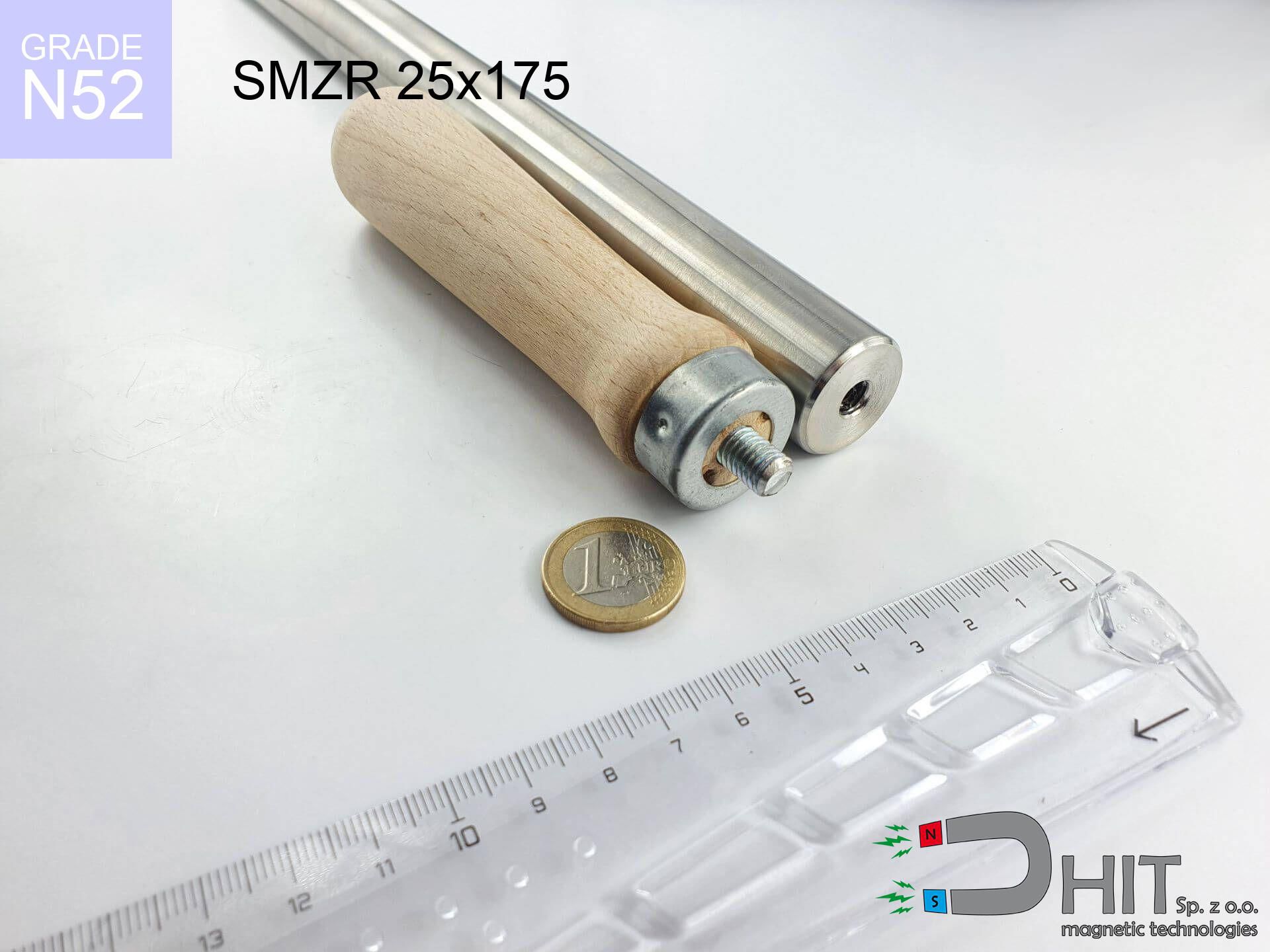MW 5x25 / N38 - cylindrical magnet
cylindrical magnet
Catalog no 010086
GTIN: 5906301810858
Diameter Ø
5 mm [±0,1 mm]
Height
25 mm [±0,1 mm]
Weight
3.68 g
Magnetization Direction
↑ axial
Load capacity
6.91 kg / 67.76 N
Magnetic Induction
615.39 mT
Coating
[NiCuNi] nickel
2.31 ZŁ with VAT / pcs + price for transport
1.880 ZŁ net + 23% VAT / pcs
bulk discounts:
Need more?Hunting for a discount?
Call us now
+48 888 99 98 98
otherwise contact us through
form
through our site.
Specifications as well as appearance of magnetic components can be calculated using our
online calculation tool.
Same-day shipping for orders placed before 14:00.
Magnetic properties of material N38
Physical properties of sintered neodymium magnets Nd2Fe14B at 20°C
Shopping tips
Pros and cons of NdFeB magnets.
In addition to their pulling strength, neodymium magnets provide the following advantages:
- Their strength is durable, and after around ten years it decreases only by ~1% (according to research),
- They feature excellent resistance to weakening of magnetic properties due to external magnetic sources,
- In other words, due to the aesthetic finish of silver, the element becomes visually attractive,
- Neodymium magnets ensure maximum magnetic induction on a small area, which allows for strong attraction,
- Neodymium magnets are characterized by extremely high magnetic induction on the magnet surface and are able to act (depending on the shape) even at a temperature of 230°C or more...
- Thanks to freedom in shaping and the ability to modify to specific needs,
- Significant place in modern industrial fields – they are commonly used in HDD drives, drive modules, diagnostic systems, also other advanced devices.
- Compactness – despite small sizes they generate large force, making them ideal for precision applications
Disadvantages of neodymium magnets:
- At very strong impacts they can break, therefore we recommend placing them in steel cases. A metal housing provides additional protection against damage, as well as increases the magnet's durability.
- Neodymium magnets lose force when exposed to high temperatures. After reaching 80°C, many of them experience permanent drop of strength (a factor is the shape and dimensions of the magnet). We offer magnets specially adapted to work at temperatures up to 230°C marked [AH], which are very resistant to heat
- Due to the susceptibility of magnets to corrosion in a humid environment, we recommend using waterproof magnets made of rubber, plastic or other material resistant to moisture, when using outdoors
- We suggest casing - magnetic holder, due to difficulties in creating nuts inside the magnet and complex shapes.
- Health risk to health – tiny shards of magnets pose a threat, if swallowed, which gains importance in the context of child health protection. Furthermore, tiny parts of these devices are able to complicate diagnosis medical in case of swallowing.
- Higher cost of purchase is a significant factor to consider compared to ceramic magnets, especially in budget applications
Highest magnetic holding force – what contributes to it?
The load parameter shown refers to the peak performance, measured under optimal environment, specifically:
- using a sheet made of high-permeability steel, functioning as a circuit closing element
- possessing a massiveness of minimum 10 mm to ensure full flux closure
- characterized by even structure
- without any insulating layer between the magnet and steel
- during pulling in a direction vertical to the mounting surface
- at standard ambient temperature
Impact of factors on magnetic holding capacity in practice
It is worth knowing that the magnet holding may be lower subject to the following factors, in order of importance:
- Gap between magnet and steel – even a fraction of a millimeter of separation (caused e.g. by veneer or dirt) diminishes the pulling force, often by half at just 0.5 mm.
- Loading method – catalog parameter refers to detachment vertically. When attempting to slide, the magnet holds significantly lower power (typically approx. 20-30% of maximum force).
- Base massiveness – too thin plate causes magnetic saturation, causing part of the power to be lost to the other side.
- Steel grade – the best choice is pure iron steel. Cast iron may have worse magnetic properties.
- Surface structure – the smoother and more polished the surface, the larger the contact zone and stronger the hold. Roughness acts like micro-gaps.
- Operating temperature – neodymium magnets have a negative temperature coefficient. At higher temperatures they are weaker, and in frost gain strength (up to a certain limit).
* Lifting capacity testing was conducted on a smooth plate of suitable thickness, under perpendicular forces, whereas under parallel forces the lifting capacity is smaller. Moreover, even a minimal clearance {between} the magnet’s surface and the plate lowers the lifting capacity.
H&S for magnets
GPS Danger
A strong magnetic field negatively affects the functioning of compasses in smartphones and GPS navigation. Keep magnets near a smartphone to prevent damaging the sensors.
Danger to pacemakers
People with a pacemaker have to keep an safe separation from magnets. The magnetic field can stop the operation of the life-saving device.
Choking Hazard
Absolutely store magnets away from children. Ingestion danger is high, and the effects of magnets connecting inside the body are life-threatening.
Do not underestimate power
Before use, check safety instructions. Sudden snapping can destroy the magnet or hurt your hand. Be predictive.
Hand protection
Mind your fingers. Two powerful magnets will snap together immediately with a force of massive weight, destroying anything in their path. Exercise extreme caution!
Cards and drives
Do not bring magnets close to a wallet, computer, or TV. The magnetism can permanently damage these devices and wipe information from cards.
Heat warning
Control the heat. Heating the magnet to high heat will ruin its magnetic structure and pulling force.
Nickel allergy
Certain individuals have a contact allergy to nickel, which is the standard coating for neodymium magnets. Prolonged contact can result in an allergic reaction. It is best to use protective gloves.
Fire risk
Powder produced during grinding of magnets is flammable. Avoid drilling into magnets unless you are an expert.
Magnet fragility
Protect your eyes. Magnets can fracture upon uncontrolled impact, launching sharp fragments into the air. Eye protection is mandatory.
Caution!
More info about hazards in the article: Safety of working with magnets.




![UMP 75x25 [M10x3] GW F200 GOLD DUAL Lina / N42 - search holder UMP 75x25 [M10x3] GW F200 GOLD DUAL Lina / N42 - search holder](https://cdn3.dhit.pl/graphics/products/ump-75x25-m10x3-gw-f200-gold-x2-lina-car.jpg)


![SM 25x100 [2xM8] / N42 - magnetic separator SM 25x100 [2xM8] / N42 - magnetic separator](https://cdn3.dhit.pl/graphics/products/sm-25x100-2xm8-feg.jpg)

